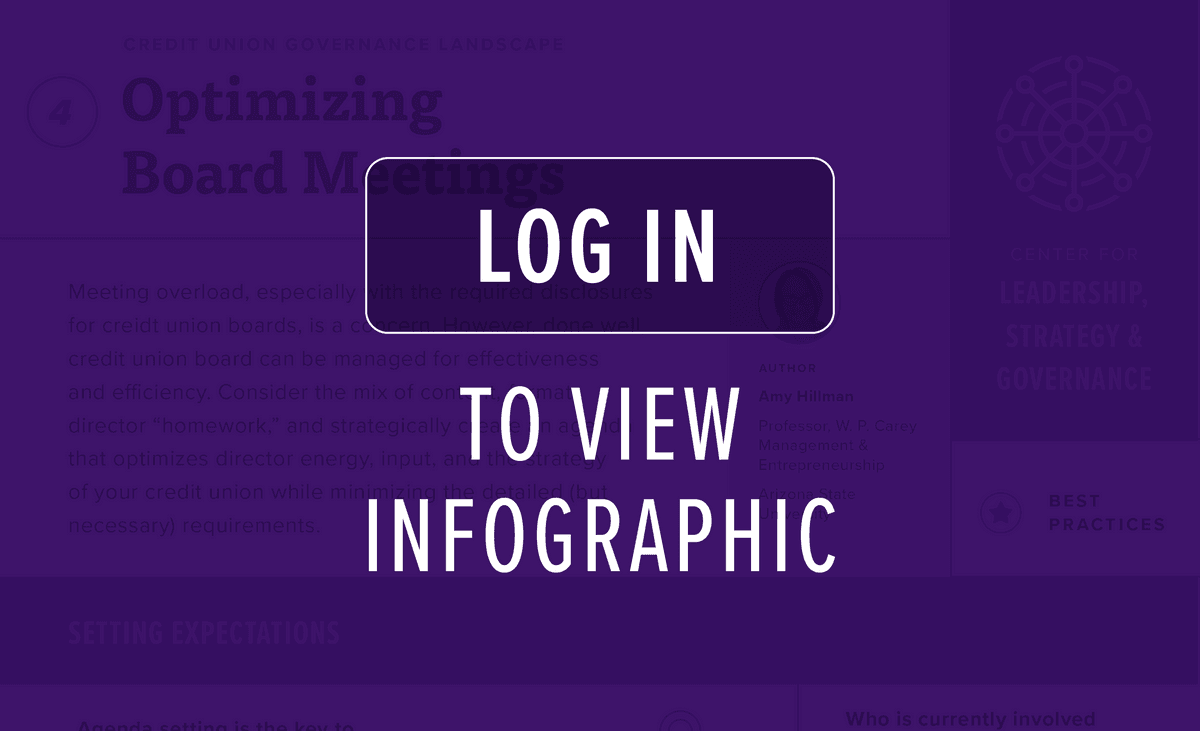As we launch each new Center of Excellence, we start by creating a shared understanding of the current state of the industry for that given topic. By benchmarking the industry against the known best practices, we can identify and prioritize the multi-year research agenda for the Center.
For the Center for Leadership, Strategy & Governance, one of the most pressing areas to dig into was in the realm of credit union governance. Center fellow, Dr. Amy Hillman, fielded a 43-question governance practices survey where credit union leaders answered questions relating to board size and makeup; director selection, education, and assessment; board responsibilities and benefits; board meetings; and CEOs/Presidents. We collected data from CEOs/Presidents (89% of respondents) and other credit unions executives with direct knowledge of their board practices (11% of respondents) at 85 US-based credit unions. The credit unions that completed the survey had a range of asset sizes, with 54% of credit union respondents with over $1B in assets, 19% between $500M and $1B, 16% between $100M and $500M, and 11% with less than $100M in assets. Our sample consisted of both federally- (44%) and state-chartered (56%) credit unions.
Bringing nearly three decades of both academic research and practical experience as a board member, Dr. Hillman has contextualized the results with governance best practices for credit union leaders to consider as they continue to shape their board to be a strategic asset.
1. Shaping Your Board to be a Strategic Asset
Boards of directors can be more than fiduciary watchdogs over management. They can be an asset helping the credit union advance its strategy and achieve its mission. Directors bring three sets of resources to the boards they sit on:
- Expertise, experience, skills, and networks
- Legitimacy, prestige, reputation
- Connections to valuable resources outside the credit union
Board composition, therefore, is more than selecting directors who are objective, understand the fundamentals to ask informed questions and lack any conflict of interest. It’s also purposefully selecting each director for their strategic human and social capital and composing your board as a portfolio of directors that reflects where the credit union is today and importantly, where you want to be tomorrow.
Here are some key best practices when it comes to shaping your board to be a strategic asset.
Boards should be benchmarked against your membership (current and prospective), your geographic diversity of operations, and the skills and expertise needed for you to succeed. Benchmarking every year, particularly as your strategy and environment shift, is crucial to ensure your board doesn’t have blindsides. In addition to thinking about the benchmarking criteria, a well-balanced board needs a mix of directors who are seasoned enough to meaningfully contribute and directors who bring fresh perspectives, but not everyone should be “new” at once. Elections should be staggered, with only a fraction of your board up for reelection in any given year.
Depending on your charter, there are formal and informal methods for ensuring board refreshment:
- Formal methods: Limit directors to 3–4 3-year terms to get adequate benefit from the investment directors make to learn the organization with the need for new perspectives. Consider a maximum age at which directors can be (re-)elected, effectively creating a retirement age.
- Informal method: Having a conversation as a board committing to term limits and/or a retirement age informally or in board “principles of engagement,” and regularly discuss it so that every director has an end in sight.
How does this apply to board chairs? What’s good for directors is also good for the board chair. Best practices suggest similarly limiting the term of your board leadership.
When considering selection criteria for new directors, create a matrix considering diversity of thought, experience, connections, demography, etc., which is revisited regularly to adjust to environment and organizational changes. In addition to relying on key internal members of your team for new director selection, consider external recruiters to bring an extra layer of expertise and reach. Credit unions are not limited to an open call among members for new directors or the networks of the existing directors to find new directors. In fact, the latter can lead to boards that are more similar and less accountable to each other because of the familiarity amongst directors.
Finally, board succession is something you should plan for. Advisory or supervisory boards are a great way to invest in potential board members. On the flip side, if you’re losing a very valuable director to term limits or retirement age, why not allow them to continue to advise in a less formal manner?
2. Making Your Boards More Effective
Having the right people is critical to building a board that can be a strategic asset, but how you onboard, assess, and ultimately use their unique talents is equally important.
Here are some best practices to consider as you think about how to make your directors as effective as possible.
Start new directors on the strongest foot possible. Onboarding a new director is as important as onboarding any hire in the credit union. For new directors, education about the credit union, the industry, financial services, relevant regulation, etc. is essential, but so is socialization around board norms, for example How do we engage as a board? What are the expectations of directors? What is the role of directors versus that of management? New directors can feel overwhelmed by acronyms and lack education on specific topics, so exposing them through purposeful content and discussion delivered by fellow board members, the CEO, and other members of the management team is a must.
Most high-performing boards also have formal mentorship program for new directors, and the most successful ones embrace mentorship as a 2-way street. The mentor has a lot to share that will make the mentee more effective quickly, but the new director was also selected for great reasons. Don’t forget that this new director can equally add value to the mentor (whether it’s another director or a credit union executive), no matter who it is.
Board education should not stop at onboarding. Credit union boards should undergo an annual evaluation to identify where education and feedback is needed. Most commonly, this is done through an annual self-assessment. Peer assessment can also be useful depending on how it’s done. Though less common, third parties are sometimes used for board evaluations. Here are some things to consider:
- For self-assessments
- Start with the criteria, establishing a matrix of what the board needs to support the organization today and tomorrow
- Using that matrix, ask directors to rate themselves on each dimension—what they’re strong in, moderate in, or feel they need development in
- For peer assessments
- Verbal assessments tend to be better accepted than written assessments, with the feedback collected and conveyed by the board chair
- As an example, the chair can ask one director at a time to leave the room and solicit feedback amongst the others about their performance. Usually this reveals how the other directors see that individual’s key value to the board and sometimes encourages more of beneficial behavior. The chair then individually discusses with each director, with another director (perhaps a former chair) providing this feedback to the chair
- For Third-party assessments
- Ensure you have very well-defined criteria or key performance indicators for the board
All of us want to know where we’re doing well and where we can improve. An annual evaluation allows you to identify these points of improvement and consider ongoing educational needs. Every board needs education in new areas relevant to the CU, such as changes in regulation, new technology, artificial intelligence, digital finance, etc. Each director also likely has areas for development revealed in their self and peer assessments. Creating individual development plans for each director is a great way to make sure you’re investing in your directors where they most need it. If only one director needs more education in finance, you invest there for him/her, but if several of the individual development plans identify understanding newer consumers is a need, you can invest in full board education.
Finally, when you identify strong, specific skillsets on your board, make sure you use them! Placing directors on committees that highlight and leverage their strengths will increase the contributions of your directors and improve your board’s effectiveness.
3. The CEO and the Board
A strong relationship between a CEO and their board requires trust. Delegation of management—including the creation of strategy, implementation of it and all operational decisions and matters—is what governance is all about. Boards delegate and trust management but must also be educated enough to ensure the best interests of credit union members are met. Directors bring important perspectives to the leadership of the credit union; they ratify the strategic direction and assist with its success through their expertise, skills, personal legitimacy as members, as well as connecting the credit union to outside resources. Thus, creating a symbiotic relationship here is key.
Here are some best practices to consider when it comes to the relationship between the CEO and the board.
When it comes to delineation of responsibilities, here’s the rule: directors should keep eyes, ears, and noses in, fingers out. Directors are not managers or operators. Directors need to carefully observe, ask questions, give things the “smell test” on whether it’s the right thing to do. However, directors aren’t there to micro-manage. Your directors are human—they have areas of interest, passion, and expertise. If they start to cross the line, reinforce that “fingers out” is the optimal path for the organization. Anyone in the credit union who is spending time responding to a director’s attempt to micro-manage, no matter what the intent, is diverting resources away from advancing the credit union. If you have a problem with this on your board, consider formally adopting a decision matrix of responsibilities that clearly delineates what management is accountable and responsible for and what the board is.
One of the most important jobs of a board of directors is hiring, evaluating, rewarding, and replacing the CEO. As CEO, your board is your biggest fan, but their job is making sure you’re the right one leading the credit union. Executive sessions, where the board meets without any credit union executives, are critically important because they allow directors to calibrate what they’re hearing, raise any questions or concerns they might have but are reticent to say in front of credit union executives, and allow the chair to funnel these matters to credit union leadership without putting individual directors on the spot. Boards should always have an executive session, every board meeting, whether it lasts 2 minutes or 20, focused on raising potential sensitive topics. However, executive sessions are not a place for the board to make decisions without the CEO.
We’ve talked a lot about board evaluation, but what about the CEO? Determining annual CEO performance metrics, measuring performance against them for compensation, and providing developmental feedback is key to a high-performing board. Ideally, CEOs receive this feedback in the spirit of improvement, learning, and advancement of the credit union. If yours is one of the few credit unions that does not evaluate the CEO annually, this is a must-change. If your CEO is doing a great job, they want to hear it; but they also want to hear where they can improve and what the board will look at moving forward.
Finally, all boards must be preparing for what, and who, is to come after the current CEO. All boards need a temporary succession plan—the proverbial “hit by a bus tomorrow” plan for who leads the credit union in the CEO’s absence. Annually, the board should also discuss who within the credit union is most capable of taking on the role longer-term, just as they should discuss succession planning for the CEO’s direct reports. CEOs need to allow their leadership team to develop relationships with the board and when a CEO is nearing retirement, formal succession planning is a must. Your board has a fiduciary responsibility to ensure a succession plan is in place.
.
4. Optimizing Board Meetings
One of the biggest complaints about credit union board meetings is the desire to spend more time on strategy and the future and less time on compliance and consent matters. Meeting overload, especially with the required disclosures for credit union boards, is a concern of many leaders. Through thoughtful consideration of the mix of content, format, and director “homework,” however, leaders can optimize director energy, input, and the strategy of your credit union while minimizing the detailed (but necessary) requirements.
Here are some best practices to consider for more effective and efficient board meetings.
Some credit union regulation specifies the number of board meetings required each year, so you have little leeway in number. However, you can determine what topics they cover, how long they last, and whether they’re face-to-face, virtual, or even asynchronous. For instance, you can dedicate the majority of longer, quarterly meetings to more strategic discussions, while holding eight shorter meetings for compliance/consent or routine matters throughout the rest of the year. Strategic discussions are a great candidate for face-to-face meetings, where relationship building, spontaneous connections, and engagement are important. Compliance, consent, and routine matters, on the other hand, can be held virtually.
Taking things a step further, have you ever considered why you hold your virtual board meetings synchronously? Some boards already hold virtual, asynchronous meetings for matters requiring consent votes. Each director goes into a portal after doing the necessary preparation and votes at a time that makes sense for them within a specified date range. If the votes are not unanimous, then synchronous discussion is used. This can allow directors to allocate their time to the board at the best time for them while still achieving the same outcome.
As you’ve gleaned by now, agenda setting is the key to achieving what you want from your board, but let’s not forget directors are also there to add unique insights and ask questions. That symbiotic relationship between the CEO and the board we discussed last week necessitates open and transparent solicitation of agenda items in advance of the board meeting. If directors don’t submit items, great, at least they were asked. If a director does and it’s a “fingers in” item, you can communicate that before the meeting and leave it off the agenda, where a real-time question might have diverted precious board time and attention.
When crafting the agenda, if you want to engage in strategic future thinking, you need time, energy, and creativity. Your board can’t be expected to do this in the third hour of a four-hour meeting. Many organizations have strategic offsites or retreats, but you can achieve the same with a longer meeting once a quarter devoted to strategy. Or, if you need to also include more operational issues and consent items in the same meeting, allocate the strategy discussion to the start, use the time needed, then move to the matters that require less discussion, scrutiny, and/or creativity.
As fiduciaries of the credit union and accountable to members, directors are expected to be fully prepared for board meetings. Keeping an agenda on track will also require directors who are prepared to have the right conversations at the right time. But are you unwittingly allowing some directors to skim, or worse skip, the board preparation packet? Prep work is just that—routine matters that require independent reading. Nothing will signal the lack of necessity of preparation to a director like recounting all the information in the meeting, so be mindful of preparation materials.
Finally, in addition to optimizing the talents of your directors, committees can be a way to manage the workload for boards. The key to committee work is trust and delegation by the full board to let a subset of most qualified directors take on that deeper work, keep the full board informed, and even make recommendations for full board adoption. Rotating members across committees can also keep fresh perspectives and avoid burnout.













